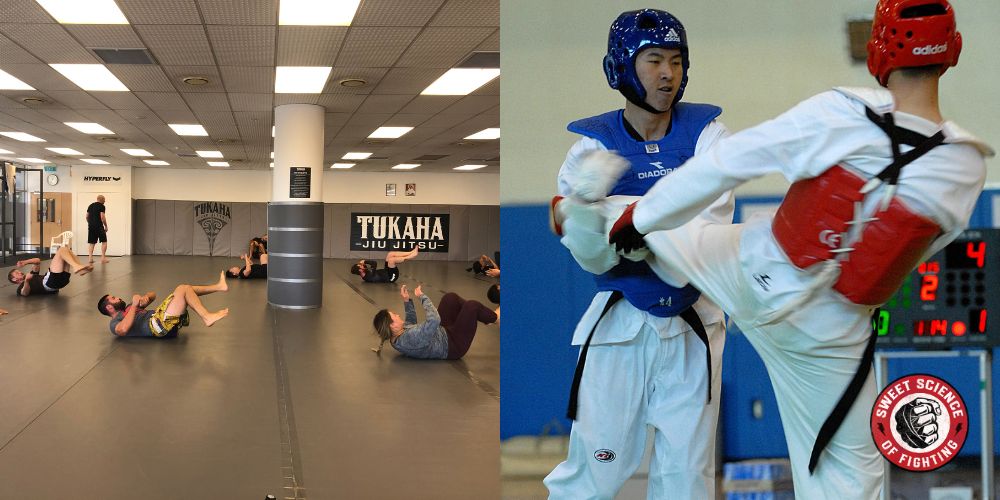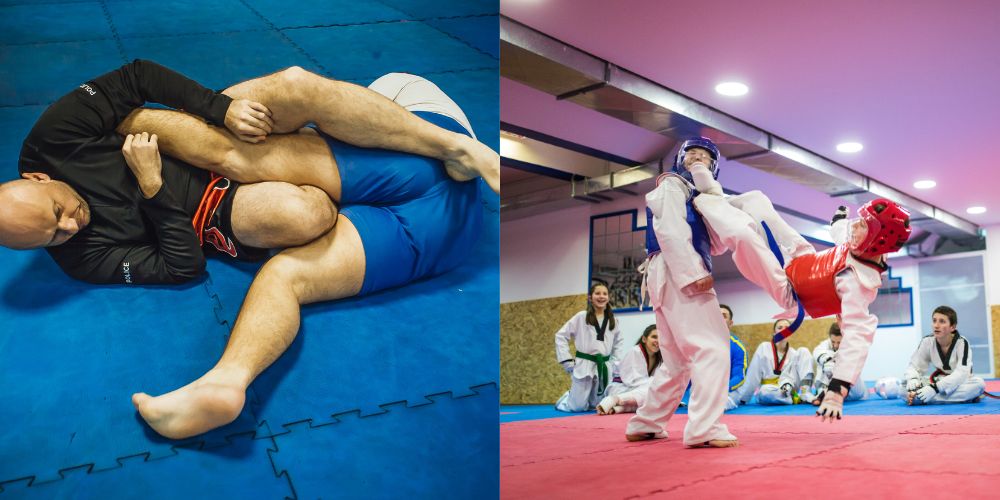Brazilian jiu-jitsu and taekwondo are worlds apart. They have had opposite approaches to combat since inception, and the rules of their sport have separated them even further. They share the common trait of being tightly specialized in one fighting area. But what are the differences?
Brazilian jiu-jitsu is a grappling martial art and combat sport focused on dominating opponents on the ground through dominant positions and submission holds. Taekwondo is a striking combat sport emphasizing almost exclusively kicks.
As you can see, the methods to victory are entirely different, but as two very popular martial arts, it’s inevitable to compare BJJ and Taekwondo in all areas.
What Is BJJ
Brazilian Jiu-Jitsu is a grappling martial art and combat sport emphasizing dominating opponents on the ground through technique, leverage, and body mechanics.
BJJ is known for its systematic approach to ground fighting, which features different positions to set up countless chokes and joint locks known as submissions.
As the name suggests, BJJ was created in Brazil, mainly by the Gracie family. A Japanese judo and jiu-jitsu master, Mitsyuo Maeda, traveled to Brazil in the early 20th century to teach students and participate in challenge matches.
His most prominent students became brothers Helio and Carlos Gracie, who took the knowledge of Maeda, focused heavily on the ground fighting techniques, and gradually created a whole new style of fighting.
BJJ has been honed and perfected through a century of live training and no-holds-barred challenges.
With the advent of modern MMA, jiu-jitsu gained wide recognition and is now one of the central pillars of mixed martial arts, without which no fighter can hope to succeed.
It’s important to distinguish between the different types of BJJ popular today to better understand their pros and cons compared to Taekwondo.
The original martial art, now known as self-defense jiu-jitsu, focuses on the most effective and safe techniques to defeat an opponent in a fight where everything is allowed.
BJJ for MMA is quite similar because of the striking, but it still has some notable differences, like the lack of a gi and the presence of other variables like MMA gloves and the cage.
On the other hand, sports BJJ is the most popular version today, and it’s a grappling-only contest with highly elaborate tactics, moves, and techniques.
What Is Taekwondo
Taekwondo is a Korean striking martial art and an Olympic sport. It is a fast-paced striking style focused almost entirely on kicks. Taekwondo kicks are many and varied, including some highly impressive jumping and spinning techniques, which are significant feats of athleticism in themselves.
The word “taekwondo” is derived from the Korean words “tae,” meaning “foot” “kwon,” which translates as “fist,” and “do,” meaning “way.” Together, the whole can be translated as “the way of the foot and fist.”
Taekwondo was created in the 1950s as an amalgamation of different Korean martial arts used throughout the centuries.
In 1955, the first recognized taekwondo school was established in Korea, and over the following few decades, the martial art gained popularity around the globe, especially after it was added as a demonstration sport to the 1988 Seoul Olympics and has been an Olympic event since 2000.
Today, there are two versions of Taekwondo, the main being the Olympic sport, Olympic Taekwondo, while the other is called ITF. Aside from popularity, the main difference is that punches to the head are allowed in ITF, but they’re not full contact.
Key Differences Between BJJ & Taekwondo

BJJ and Taekwondo have a night-and-day difference. They have opposite approaches to fighting, and the few common things they share are a similar traditional uniform and the fact that both are highly competitive and well-developed sports, so the main comparisons will feature the sports versions of both.
Rules and Objectives
Key features and rules of sports BJJ
- Sports BJJ is a grappling-only contest with no striking allowed.
- A match can be won by submission or on points.
- Submissions include joint locks and chokes, with some dangerous ones banned for certain levels.
- Points are awarded for finishing takedowns and sweeps or for obtaining dominant positions like mount, back control, side control, and knee on belly. There are also submission-only rulesets where no points are scored.
- Match length varies between 5 and 10 minutes, but even no time limit matches exist.
- Two distinct versions of sports BJJ exist- gi and no-gi.
Key features and rules of Olympic Taekwondo
- Striking only, with no grappling allowed.
- Punches to the head are banned; only punches to the trunk protector are allowed.
- Matches are full contact and can be won via a knockout or on points.
- The length of a match is 3×2 minute rounds.
- Punches to the body score only 1 point, while kicks score more depending on the target it lands and the quality of the kick. Kicks to the head score more than kicks to the body, and turning kicks score more than regular ones.
Techniques
The name of the game in BJJ is positions and submissions. Jiu-jitsu prides itself on being a precise art that values technique over strength and power. Various positions achieve this, each allowing different submission holds and control over the opponent.
The most distinct positions in BJJ are the guards, used to defend and control the opponent while he is on top. Unlike other grappling sports where being on your back means losing, in BJJ, guards play a significant role in the game and offer many offensive options, not simply a way of defending.
The submissions in BJJ are countless and include chokes like the popular guillotine choke, rear naked choke, and triangle choke, as well as joint locks like the armbar, Kimura, and heel hook.
Taekwondo is all about kicking. Low kicks are banned by the rules, as is face punching. Turning and spinning kicks score higher than usual, making them fast, flashy, and acrobatic.
This super narrow level of specialization makes Taekwondo kicks some of the deadliest across all striking sports.
Equipment
The traditional uniforms of BJJ and Taekwondo are one of the few things they share. The BJJ gi comprises a heavy cotton jacket and trousers, with a colored belt denoting rank.
The taekwondo uniform is called a dobok, and while the thickness and composition are different, as a whole, it’s very similar to the gi because both derive from the traditional Japanese kimono. Taekwondo also has a strict ranking system using colored belts to show progression.
BJJ has another form that has already taken over in terms of popularity, and it’s called no gi. As the name clearly shows, practitioners do not use a kimono but rather a tight-fitting rash guard on top and fight shorts on the bottom. Aside from clothing and a mouth guard, BJJ generally doesn’t require any other equipment.
On the other hand, Taekwondo has a large set of protective equipment used in tournaments. Competitors wear:
- Head Guard
- Mouthguard
- Chest guard called a hogu
- Shin pads and foot socks
- Hand gloves
- Forearm guards
High-level taekwondo tournaments use electronic hogus, foot socks, and head protectors, which are used to determine the scoring techniques.
Belt System
Brazilian jiu-jitsu and Taekwondo have adopted a structured hierarchy system represented by colored belts, with each color denoting the wearer’s rank. This presents a clear order and tangible goals for all practitioners.
While the overarching concepts are the same, the system of awarding the belts and the number of ranks differ between jiu-jitsu and Taekwondo.
The two leading taekwondo organizations, the WTF and ITF, have slightly different belt systems. They both separate practitioners into two main groups- junior and senior. The junior ranks are called “geup,” and the senior are “dan.”
The geups in World Taekwondo (the Olympic version) start from 12 and reach 1, and the colors representing them are white, yellow, orange, green, purple, blue (jr. and sr.), brown (jr. and sr.), red, junior black belt and finally black.
Then you start climbing the senior dan ranks, all of which are black belts with stripes. The ITF system is the same, but the geups are 10, not 12, with fewer colors.
Brazilian jiu-jitsu has a much simpler but harder-to-climb rank system consisting of fewer belt colors- white, blue, purple, brown, and black.
Then, once you reach the black belt, you start climbing a degree system, reaching up to ten, just like the dan system in Taekwondo, Karate, and many other martial arts.
Not only are the belt colors in BJJ fewer, but the way they are earned is very different than in Taekwondo.
To be promoted in the Korean martial art, you will need to pass a formal test, where you will perform set forms, techniques, physical exercises, and sparring rounds specific for each rank. These tests are often held multiple times a year, and if you consistently train, you can climb the ranks quite fast.
In BJJ, there are no formal tests or specific requirements everyone must comply with. The instructor exclusively determines promotions.
There are some rough guidelines you must check at each rank. Still, they can vary from gym to gym, and most instructors value conceptual and behavioral progress more than mastering specific techniques.
This type of promotion and the mindset set by the early masters makes the BJJ system one of the hardest to progress, and most people spend years at one rank before being promoted.
Competitive Scene
A big part of the popularity of both Taekwondo and BJJ is owed to their well-developed competitive circuits and focus on the sport element.
While this reduces some practicality because the focus shifts from all-around fighting to discovering ways to win under a specific ruleset, competitions present concrete goals for practitioners, a pressure testing field, and create interest from casual observers.
BJJ began developing as a sport in Brazil during the 1970s but gained immense traction during the 1990s when it spread to the USA.
The following growth in the number of practitioners, organizations, and places you could train and compete has been nothing short of amazing. Today, many countries on all continents have some competitive scene.
On the higher end of the spectrum, traditional gi BJJ is still mainly governed by the IBJJF, and competition there is fierce, while the ADCC represents the pinnacle of no-gi submissions grappling.
During the last 10 years, a new form of professional-level events with a similar structure to MMA and boxing have been created.
Organizations like Polaris, Metamoris, EBI, WNO, and others are taking submission grappling to the forefront of the combat sports world, and the sport is on the cusp of mainstream popularity.
On the other hand, Taekwondo is much older and has been a full Olympic event since the Syndey 2000 games.
As such, the sport is immensely popular and competitive and has the privilege of receiving government funding in many countries.
Taekwondo lacks a professional competitive scene, but it thrives as an amateur sport with many continental and world championships, leading to the Olympic games as the sport’s peak.
BJJ vs. Taekwondo For MMA

While BJJ is no longer the dominant force it was early in modern MMA history, it remains a crucial element of the mix.
Like famous MMA coach Firas Zahabi said, you may not win by submission in MMA, but you will surely lose by one if you don’t know BJJ. On that basis, BJJ is infinitely more important than Taekwondo for MMA.
Groundwork is one of the prominent elements of fighting, and jiu-jitsu has been proven undoubtedly to be one of the best grappling styles.
Even if you train only to defend against typical BJJ moves and tactics, you must always account for them in MMA.
Taekwondo is not without merit for cage fighting, though. The insane flexibility, athleticism, and range management can be translated to MMA, and many successful fighters have done so.
Even flashy kicks have been successfully used, so Taekwondo can provide an excellent base to build a complete MMA skillset. Fighters like Anthony Pettis and Yair Rodrigues have proven this with their success.
But the uses are much more situational and optional, while BJJ knowledge is mandatory for MMA, making it far superior.
BJJ vs. Taekwondo For Self-Defense
As a martial art created for self-defense and tested countless times against real opponents, BJJ is a clear winner in self-defense utility.
It allows significant gaps in strength and size to be negated on the ground through superior positioning and leverage, which makes it so good for street fights. The ability to control or submit a person without severely hurting him is another good reason BJJ is as popular as a self-defense system.
There are, of course, flaws in it. Going to the ground when there is more than one attacker is suicidal, and you never know if an assailant won’t produce a blade.
The lack of striking in BJJ also creates a significant gap in the skills that may be useful in a street situation. Sports BJJ does not account for striking even in defense and may lead to some dangerous habits in real-life violent confrontations.
On the other hand, Taekwondo has something to offer for self-defense, but the uses are situational.
The lightning-fast kicks and the ability to quickly cover distance may be perfect for a scuffle in a larger open space where you want to attack swiftly and escape the situation. Body kicks can also quickly render attackers helpless.
But relying on head kicks for street fights is not a good idea and the lack of punching and grappling leaves Taekwondo with too much to be desired as a means of self-defense.
Who Would Win a Fight Between BJJ and Taekwondo?

One thing is sure: 9 out of 10 times, a grappler beats a striker if the striker has no grappling skills. This has been proven in countless MMA matches and street fights, where the grappler shortens the distance, takes the striker down, and dominates him completely.
Some strikers, like Muay Thai guys, have a much better chance because they can hit from up close with knees and elbows and have a very stable base and clinching skills.
Taekwondo relies on high kicks to a standing opponent, which is unlikely to hit a crouching BJJ guy just looking to cover up and grab hold of you.
Based on the wealth of footage and countless matches we’ve watched, I can undoubtedly say BJJ wins a one-on-one fight with Taekwondo.
Is BJJ Better Than Taekwondo?
For me personally, BJJ is much better than Taekwondo across all areas, but this is an unfair assessment to make in general because both martial arts have a lot to offer their practitioners, and each comes with its pros and cons.
BJJ is better for self-defense and MMA and has much lower physical demands, making it more accessible.
Taekwondo is more popular among kids who have the necessary flexibility and agility. The whole training system of Taekwondo is geared more toward kids, and it’s an excellent first martial art for them.
Both have well-developed competition scenes and schools worldwide, so accessibility shouldn’t be a problem regardless of your choice. Despite that, I am leaning heavily toward BJJ in this comparison. Taekwondo is still a great martial art and sport with much to offer its students physically and mentally.
So, if the ideas of kicking and acrobatics in combination with traditional martial arts values attract you, Taekwondo is better. For all other purposes, BJJ is far superior.

